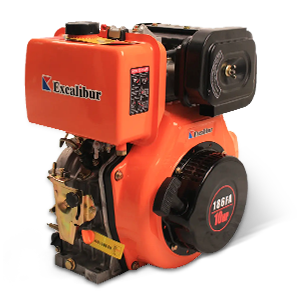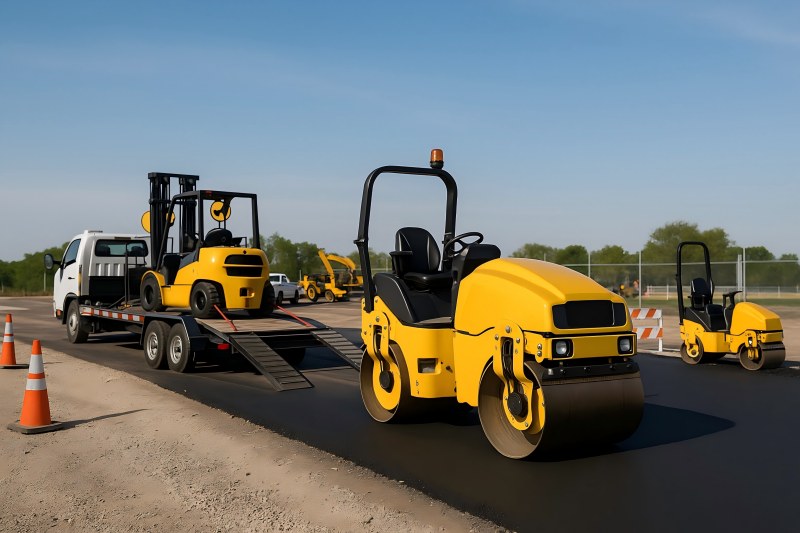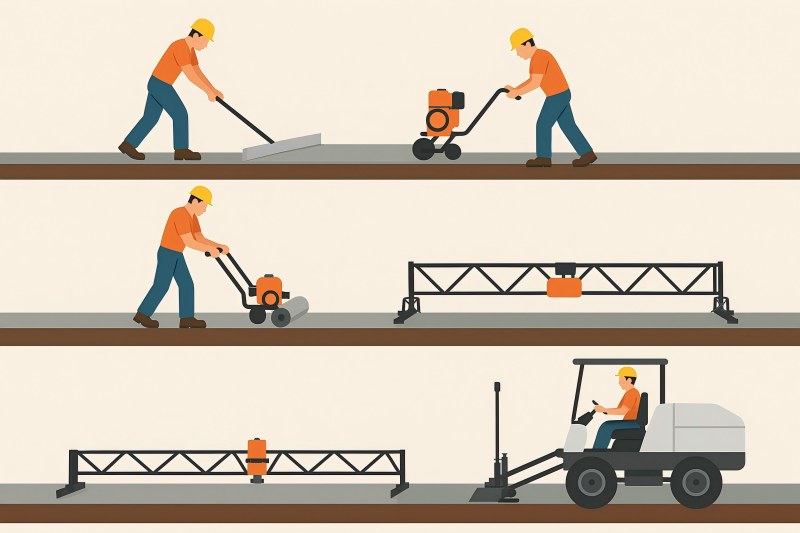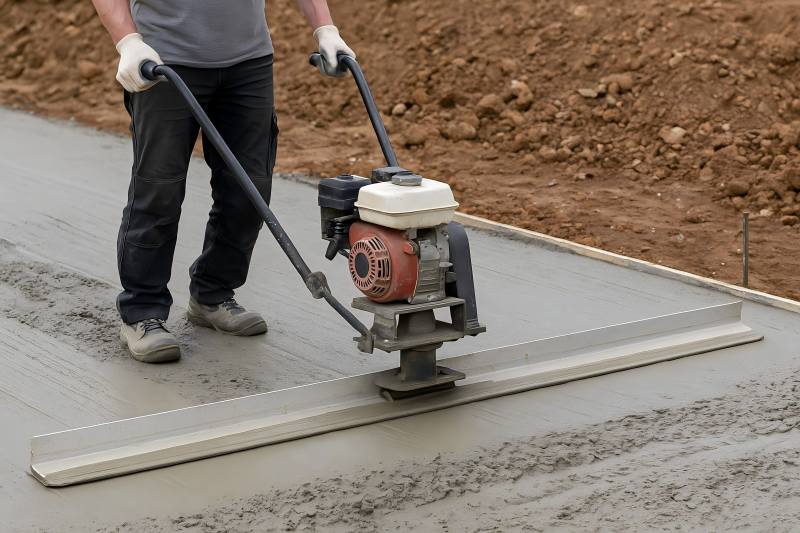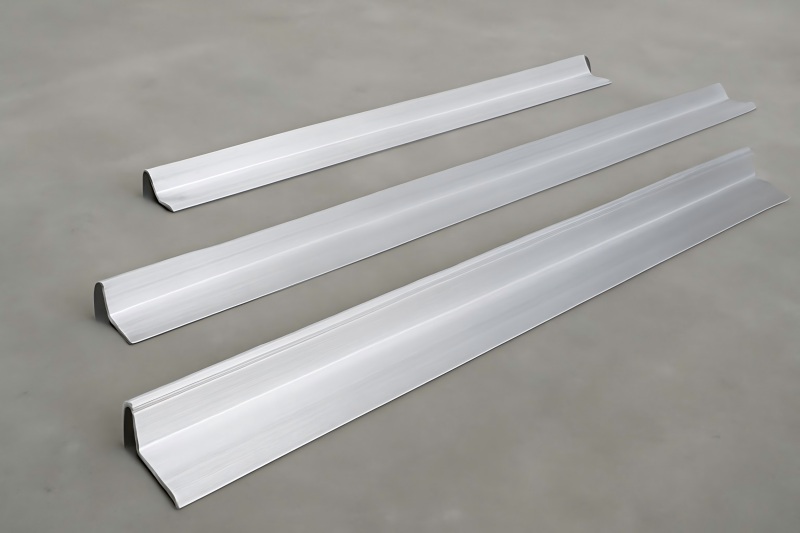Choosing whether to rent or buy a small road roller can swing your job costs by thousands over a season. This guide breaks down every major cost component—purchase price, rental rates, delivery, fuel, maintenance, insurance, depreciation, and financing—and then walks you through practical break-even examples for two common categories:
- Walk-behind / pedestrian double-drum rollers (≈24–26 in drums)
- Compact ride-on tandem rollers (≈1–3 metric tons; ~36–51 in drums)
You’ll leave with a decision framework, formulas you can reuse, and “rule-of-thumb” thresholds that help you decide fast.
What counts as a “small” road roller?
Walk-behind / pedestrian rollers: Typically 24–26 in double drums; widely used for patches, driveways, paths, and tight work zones. Represented by many brands/models; example prices for double-drum pedestrian units in India list around ₹110,000–₹500,000 (≈$1,300–$6,000+) depending on spec and brand.
Compact ride-on tandem rollers (≈1–3 ton): Common on parking lots, lanes, shoulders; e.g., Cat CB4.0 (3–5 t, 51 in drums) and Sakai SW354 (≈3 t, 47 in drums).
Why this matters: rental rates, purchase prices, fuel burn, and delivery haulage all scale sharply with size.
What does renting really cost?
Your invoice often includes more than the “headline” daily rate:
Base rental rate
Typical published rates (size, market, and demand vary):
- Walk-behind 26″ double-drum: ~$188/day, ~$690/week, ~$1,638/month.
- Small ride-on 36″–48″: $125–$350/day published examples; weekly ~$1,200; four-week ~$3,100 for a 3–5 ton ride-on.
- Regional shop examples for 3,000–6,000 lb rollers: $225–$575/day with weekly/monthly discounts.
Delivery & pickup (haulage)
Local outfits commonly charge a minimum plus per-mile beyond a radius—e.g., $60 each way within 10 miles, then ~$2.50/mile. Expect higher for heavier gear or metro congestion.
Damage waiver / rental protection
Many dealers add a Loss/Damage Waiver (often 10–20% of the rental rate; one dealer posts 14%). This is not insurance and often excludes negligence/theft caps.
Fuel
You pay for fuel. (Day/week/month definitions also matter: a “day” is typically one 8-hour shift.)
Summary: For a short job, delivery and waiver can add 20–50% to the base day rate. For multi-week jobs, those extras dilute per day.
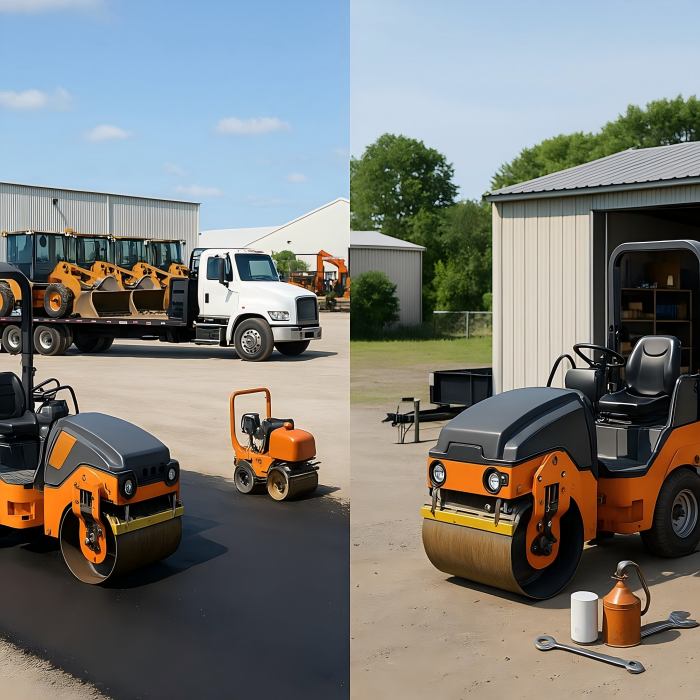
What does buying really cost?
Up-front price (CAPEX)
- Pedestrian double-drum: New units commonly in the low thousands USD range (brand/spec/market dependent).
- Compact ride-on (≈3 ton): Example listing shows a 3-ton full-hydraulic dual-drum around $32,000; other new 1–3 t options vary widely by brand and region.
Ownership costs you’ll carry
Depreciation & resale: Expect to recover part of your CAPEX at resale; the spread (purchase minus resale) is your real depreciation cost.
Financing (cost of capital): Interest or opportunity cost if you pay cash.
Insurance, taxes, registration: Usually a small annual percentage of asset value.
Storage & security: Yard space, theft risk mitigation.
Maintenance & repairs: Oil/filter services, hydraulics, vibratory system, bearings, water/spray systems, wear parts. Typical service intervals: ~250–500 hours between services, depending on machine class.
Fuel: Small rollers vary; indicative reference points:
- Cat pneumatic rollers list ~1.45–1.8 gal/hr in telematics-based summaries (model dependent).
- Some small diesel units cite ~1–2 gal/hr; micro/pedestrian diesels can be far lower (e.g., a small Lombardini-powered unit claimed ~1.35 L/hr). Treat these as ballpark, not promises, and check your model’s spec sheet.
Tip: Your dealer’s cost-per-hour templates (or EquipmentWatch Blue Book methodology) split ownership (fixed, per month or year) and operating (per hour), which is the most reliable way to compare.
Tax treatment (U.S.)
Many buyers can elect Section 179 / bonus depreciation (limits change; verify the current year) instead of straight-line MACRS. For authoritative guidance, use IRS Publication 946 and your CPA; online summaries often lag law changes or conflict.
Build a comparable cost model
Use a 3-bucket structure:
- Fixed ownership (per year) = Depreciation (Purchase − Expected Resale)/Years + Insurance/Taxes + Financing cost.
- Variable ownership (per day) = (Fuel/hr + Maintenance/hr) × Hours/day.
- Rental (per day) = Base day rate + Damage waiver + (Delivery ÷ Job days) + Fuel.
You’re finding D (days/year) where:
- Fixed_own/year ÷ D + Variable_own/day = Rental/day
- Solve for D to get your break-even utilization.
Worked example A — Compact ride-on (≈3-ton) tandem
Assumptions (illustrative, adjust to your reality):
- Purchase price: $32,000 (3-ton class example).
- Resale after 3 years: $16,000 (50%—varies by brand/market).
- Depreciation: ($32,000 − $16,000) ÷ 3 = $5,333/year.
- Insurance/taxes/storage: $1,200/year (assumption).
- Cost of capital: 8% on average book (~$24,000) ≈ $1,920/year (assumption).
- Fuel use: ~1.8 gal/hr (reference, model dependent). Diesel $4.00/gal → $7.20/hr fuel.
- Maintenance/repairs: $7.00/hr (assumption; within typical light-roller ranges; tighten with your dealer).
- Hours/day: 8.
Compute ownership:
- Fixed_own/year = 5,333 + 1,200 + 1,920 = $8,453.
- Variable_own/day = (7.20 + 7.00) × 8 = $113.60/day.
Rental comparators (published examples):
- Day: 3–5 ton ride-on listed at $350/day; 4-week at $3,100 (=$155/day).
- Damage waiver: assume 14%.
- Delivery & pickup: assume $120 roundtrip local, amortized over job length.
- Fuel: you still pay it when renting (same $7.20/hr).
Effective rental per day (illustrative):
- 1-day job: $350 + (14% of 350 = $49) + $120 delivery + $57.6 fuel ≈ $579/day.
- 5-day week: ($1,200/5 = $240) + ($168/5 = $33.6) + ($120/5 = $24) + $57.6 fuel ≈ $358/day.
- 4-week month: ($3,100/20 = $155) + (~$434/20 = $21.7) + ($120/20 = $6) + $57.6 ≈ $243/day.
Break-even (days per year):
Solve: $8,453 / D + 113.6 = Rental/day
- Vs weekly-style rate (~$358/day) → $8,453/D = 244.4 → D ≈ 34.6 days/year.
- Vs monthly-style rate (~$243/day) → $8,453/D = 129.4 → D ≈ 65.3 days/year.
- Vs true 1-day rentals (~$579/day) → $8,453/D = 465.4 → D ≈ 18.2 days/year.
Interpretation:
If you tend to rent in short bursts (1–2 days at a time with full delivery each job), buying can pencil out above ~20 days/year of use.
If your rental pattern is monthly (deeply discounted), you typically need ~65+ days/year to win on ownership under these assumptions.
Sensitivity: Used purchase, better resale, lower fuel, or lower insurance shrink the break-even; higher interest, poor resale, or minimal use push it out. Track your actuals.
Worked example B — Walk-behind pedestrian double-drum
Assumptions:
- Purchase price: $6,000 (illustrative; new pedestrian rollers often land in low-thousands USD; regional examples show ₹110k–₹500k).
- Resale after 3 years: $2,400 (40%).
- Depreciation: ($6,000 − $2,400) ÷ 3 = $1,200/year.
- Insurance/storage: $300/year.
- Cost of capital: $400/year (assumption).
- Fuel: small diesels/gas often ≤1 gal/hr; use 0.5 gal/hr @ $3.75 → $1.88/hr (round to $2/hr).
Ownership:
Fixed_own/year = 1,200 + 300 + 400 = $1,900.
Variable_own/day = (2.0 + 2.5) × 8 = $36/day.
Rental comparator:
26″ walk-behind: $188/day; $690/week; $1,638/month. Damage waiver 14%. Pickup yourself (assume $0 delivery), fuel same as above.
Effective rental per day (with self-pickup):
Day: $188 + $26.32 + fuel (~$16) ≈ $230/day.
Break-even: $1,900/D + 36 = 230 → $1,900/D = 194 → D ≈ 10 days/year.
Interpretation: If you’ll use a pedestrian roller ≥10 days/year, owning often beats renting—especially if you can store/transport it easily.
Productivity & fuel: don’t ignore output per day
Ride-on vs pedestrian: A 3-ton ride-on can finish 30–45% faster than a pedestrian roller on like-for-like work, which reduces job overhead and labor. That advantage often outweighs a higher fuel burn. If your scope frequently stretches a pedestrian unit, stepping up in class can cut total project cost.
Fuel optimization: OEM “Eco” modes on larger rollers can cut daily consumption meaningfully (e.g., measured reductions in controlled tests). Smaller machines may benefit less, but smart throttle/vibration discipline always saves.
Delivery, damage waivers, and the fine print (renting)
Day/Week/Month definitions: Many rentals define a “day” as one 8-hour shift (overtime may bill extra).
Delivery math: At $60 each way within 10 miles (example), a 1-day job adds $120 (a big adder). Over 20 working days, it’s only $6/day. Plan job bundling to amortize haulage.
Damage waivers (10–20%): Understand exclusions (negligence, theft caps, deductibles). If you have solid contractor’s equipment coverage, you may decline the waiver—if your policy and the rental contract permit it.
Beyond the math: operational considerations
Reasons to rent
- Flexibility: Right size for each job; return when done.
- No wrenching: Maintenance, breakdown swaps handled by rental house; you
- Cash conservation: Keep capital for labor or high-return tools.
Reasons to buy
- Availability & schedule control: No waitlists in peak season; mobilize at dawn.
- Standardization: Same controls/features; fewer operator errors.
- Resale value: Well-kept small rollers often hold value, lowering true depreciation cost.
- Utilization synergy: If you already own a trailer, tow vehicle, and shop capability, your true ownership cost drops.
Risks when buying used
Vibration bearings, hydraulics leaks, drum shell condition, water system issues, and hard-to-source parts. Budget a post-purchase refresh if hours are high.
Sample tables you can reuse
Table A — Inputs you should collect
| Input | Walk-Behind | Ride-On 1–3 t | Notes / Sources |
| Base rental (day / week / 4-wk) | $188 / $690 / $1,638 | $350 / $1,200 / $3,100 | Published examples; vary by city/season. |
| Damage waiver | 10–20% (e.g., 14%) | 10–20% (e.g., 14%) | Check contract; not insurance. |
| Delivery & pickup | $0–$120+ | $120+ typical (local) | Often min fee + per-mile. |
| Fuel use (gal/hr) | ~0.3–0.8 | ~1.0–2.0 | Model-specific; verify OEM data. |
| Purchase price (new) | Low thousands USD | Tens of thousands USD | Examples vary by brand/region. |
| Service interval | 250–500 hr | 400–500 hr typical | Plan PM windows. |
Table B — Example outcomes from the worked scenarios
| Scenario | Effective Rental / Day | Ownership / Day at 20 d/yr | Ownership / Day at 50 d/yr | Break-Even (≈days/yr) |
| Ride-on (1-day jobs) | ~$579 | ~$539 | ~$285 | ~18 |
| Ride-on (weekly) | ~$358 | ~$539 | ~$285 | ~35 |
| Ride-on (monthly) | ~$243 | ~$539 | ~$285 | ~65 |
| Walk-behind (day, pickup) | ~$230 | ~$131 | ~$74 | ~10 |
Practical tips to lower total cost (whichever path you choose)
Bundle jobs to amortize delivery over more days (renting) or eliminate it with your own trailer (owning).
Specify drum width & vibration needs precisely; don’t oversize “just in case.”
Track real fuel/hr per machine; train operators on idle control and correct vibration amplitude/frequency.
Compare weekly vs monthly rental: big step-downs in effective day rate can change the decision.
Ask rental houses for swap-out guarantees during peak season—downtime is expensive.
If buying used, insist on a hot run (vibration on), drum temperature checks (asphalt), sprinkler flow, and a hydraulic leak-down test.
For walk-behind rollers, buying often wins above ~10 days/year of use—especially if you can self-transport and store it.
For ride-on 1–3 ton rollers, the break-even commonly lands between ~35 and ~65 days/year, depending on whether your alternative is a weekly or monthly rental and how you handle delivery and damage waivers.
If your work is sporadic, seasonal, or highly variable in size, renting preserves flexibility and offloads maintenance risk.
If you have steady demand, tight schedules, and existing transport/shop capability, ownership creates predictable availability and generally lower cost per productive day.
Use the formulas above with your real quotes (rental and dealer) and verify tax options with your accountant (IRS Pub 946 is the authoritative reference). With a few local numbers plugged in, your rent-vs-buy answer becomes clear—and defensible in a bid review.

